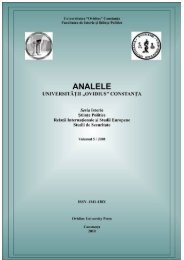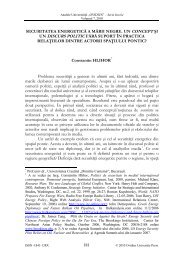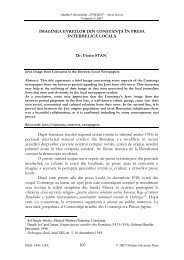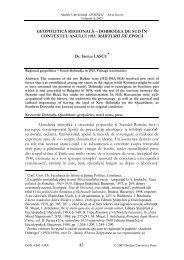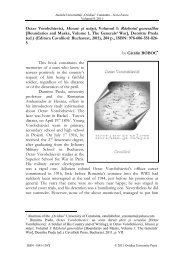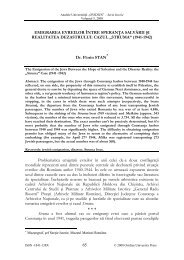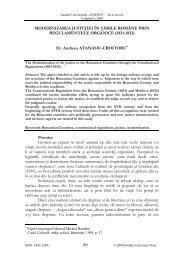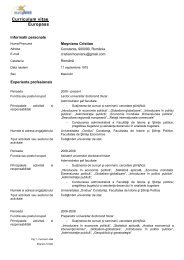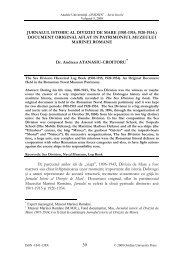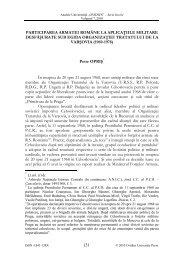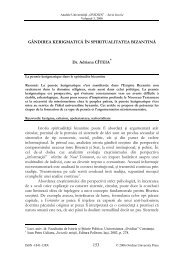analele universitÄÅ£ii âovidiusâ constanÅ£a - AUOCSI
analele universitÄÅ£ii âovidiusâ constanÅ£a - AUOCSI
analele universitÄÅ£ii âovidiusâ constanÅ£a - AUOCSI
You also want an ePaper? Increase the reach of your titles
YUMPU automatically turns print PDFs into web optimized ePapers that Google loves.
Nicolae Iorga’s Opinion on Early Modern Scotland Analele Universităţii „OVIDIUS” / Vol. 6/ 2009<br />
University or in general with the whole Scottish urban culture. 41 Regarding the<br />
Scots clans, Duncan Forbes of Culloden famously describes them as a group of<br />
people sharing the same name and kinship, and each clan also consisting of<br />
other subordinate branches, each of them with its own chief, but all of them<br />
owning loyalty to the supreme clan chief. 42 So, in clan organization, the most<br />
important persons were not the relatives of the supreme chief, but the lesser<br />
chiefs. Also, in order to avoid confusion, clan members were not called after<br />
their family name. For example, in clan Grant, only the chief was called Chief<br />
Grant or Laird Grant, his vassals were also called Grant and then followed the<br />
name of their property. Thus, in official documents they appeared as John<br />
Grant of Sheuglie, although in everyday life Sheughlie alone would have been<br />
used. In some cases, in order to distinguish between father and son, their<br />
military rank was also included in the name. 43<br />
Even though this great Scots nobility could access Charles I’s court, and<br />
a few chiefs were indeed present there, the King did not seek to cultivate his<br />
relationship with them. Also he never attended trials in Edinburgh, and did not<br />
take part in Exchequer sessions, where he could have improved his<br />
administration of Scotland. 44<br />
He did not try to understand his ancestral land, where the Kirk was<br />
rather the representative body of the nation, through its synods and covenants.<br />
In 1635 King Charles I issued a series of indications for the Kirk without<br />
bothering to call a general convent. More so, he went on with his father’s<br />
(wisely) abandoned project of a new Scottish Liturgy. The ensuing Liturgy of<br />
1637, as it would be known, was certainly not the English Book of Common<br />
Prayer, nor Archbishop Laud’s Liturgy, the later at least being written after<br />
consulting the – few and unwanted – Scots Bishops. 45<br />
Thus, this Liturgy of 1637 – which did not have the approval of a<br />
Presbyterian Covenant – was to be read in all the churches, imposing changes in<br />
religion upon all Scots, a hard to accept fact. In the St. Giles Cathedral the<br />
bishop had not even finished reading two pages that the riot began. Jenny<br />
Geddes, a Scots woman, is especially remembered for allegedly having projected<br />
her stool at the Bishop of St. Giles, after loudly complaining of his saying<br />
Mass. 46 The – luckier – Bishop Whitford of Brechin managed to finish the<br />
41 Murray G.H. Pittock, The Jacobite Cult, in Edward J. Cowan (coord.), Richard J. Finlay<br />
(coord.), „Scottish History: The Power of the Past,” Edinburgh University Press, Edinburgh,<br />
2002, pp. 191-192.<br />
42 Stuart Reid, Highland clansman 1689-1746, Osprey Publishing, p. 3.<br />
43 Ibidem, p. 5.<br />
44 Rosalind Mitchinson, op. cit., p. 124-125.<br />
45 Ibidem, p. 146-147.<br />
46 Peter & Fiona Sommerset Fry, op. cit., p. 170.<br />
ISSN -1841-138X 213 © 2009 Ovidius University Press



